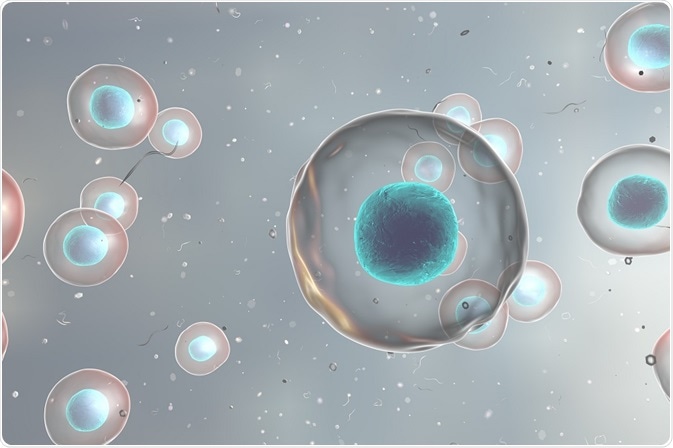
How are the Metabolome and Proteome Related?
The proteome describes all the proteins within a cell, whereas the metabolome describes all the metabolites. The two are connected by many aspects of cell biology, in particular; cell signaling, protein degradation and generation, and post-translational modification.

Credit: Kateryna Kon/Shutterstock.com
What is the proteome?
The proteome describes a complement of proteins expressed in a cell, tissue, or an organism. This also includes protein isoforms and post-translational variants. Although mRNA levels can be gauged accurately using microarray, it is necessary to examine the proteins and their levels to gauge the rate of protein translation and degradation that is not clear for every mRNA.
In addition, post-translational modifications such as phosphorylation, ubiquitination (which modulates protein activity and mediates signal transduction), and proteolytic cleavage can determine the fate of protein activity.
Although proteomic analysis can provide crucial information on protein activity, it has some disadvantages:
- The proteome size is several folds higher than the genome size with the number of proteins >100,000.
- It is difficult to detect low-level proteins.
- Detection of proteins involves the use of large-scale, high-throughput screening (HTS) of protein content.
- Although proteomics provides extensive information about the genotype, it provides limited information about phenotype.
What is the metabolome?
Metabolome profiles all the metabolites present in a cell, tissue, or organism. It includes a diverse array of small molecules, including peptides, carbohydrates, lipids, nucleosides, and catabolic products of exogenous compounds.
It forms a comprehensive set of both signaling and structural molecules, and thus is a field of intense investigation. Metabolome reflects the final downstream product of gene transcription and is closest to the phenotype of the biological system.
Although the size of metabolome is much smaller than the proteome (~5000 metabolites), it represents a diverse array of small molecules with functional significance with respect to molecular and biochemical signatures. Metabolomics is widely used in different fields, such as microbiology, nutrition, agriculture and environmental sciences, and clinical and pharmaceutical fields.
Connection between proteome and metabolome
As the proteome consists of proteins and metabolome consists of an eclectic mix of molecules, ranging from amino acids, peptides, lipids, and carbohydrates among others, it is easy to forget that these two groups are intimately connected.
Protein degradation into metabolites
Proteins are composed of amino acids (metabolites) and they degrade by a process termed as proteolysis. Protein catabolism breaks down proteins to amino acids that are further catabolized to yield glutamate following the deamination process. Amino acids can also be catabolized to yield urea, uric acid, pyruvate, ammonia, creatinine, and trimethylamine N-oxide. All these products are metabolites. Any change in the protein stability and degradation can bring about changes in the metabolome.
Post translational modifications (PTM) by metabolites
Many of the PTMs are brought about by metabolites. Metabolites such as phosphates, sugar, alcohols, organic acids, polypeptides, complex molecules, and aldehydes cause phosphorylation, glycosylation, ubiquitination, lipidation, and carbonylation. Data on the type of PTM can be obtained by measuring the concentration of different metabolites in the protein leading to its active or dormant state.
Metabolites as cofactors
Most proteins also use metabolites as cofactors (NADH or flavin), signaling molecules (calcium, nitric oxide, zinc, and prostaglandins), substrates, and stabilizing agents.
Analysis of proteomes and metabolomes are carried out by techniques such as Nuclear Magnetic Resonance spectrometry (NMR), x-ray diffraction, and high-pressure liquid chromatography. Proteomics and metabolomics involve characterizing the two-dimensional and three-dimensional structures of the target molecules and identification of interconnected networks or pathways.
Proteome and metabolome are closely intertwined with many studies using the Trans-OMICS approach in therapeutics such as innovative cancer therapies, kidney transplantation and so on.
Reviewed by Deepthi Sathyajith, MPharm
Sources:
- Global strategies to integrate the proteome and metabolome. Scripps Institute.
- https://www.tandfonline.com/doi/pdf/10.1586/14789450.4.3.333
- obgyn.onlinelibrary.wiley.com/doi/pdf/10.1576/toag.13.3.189.27672
- Kawabata-Iwakawa R, Nishiyama M. [Towards Development of Innovative Cancer Therapies - Trans-OMICS Approach. [Article in Japanese]. Gan To Kagaku Ryoho. 2018 Mar;45(3):405-11.
- Christians U, Klawitter J, and Klawitter J. Biomarkers in transplantation – Proteomics and Metabolomics. Ther Drug Monit. 2016 Apr;38 Suppl 1: S70-4
Further Reading
Last Updated: Apr 17, 2018





















.png)












No hay comentarios:
Publicar un comentario